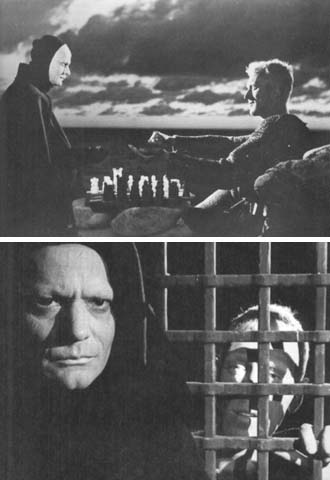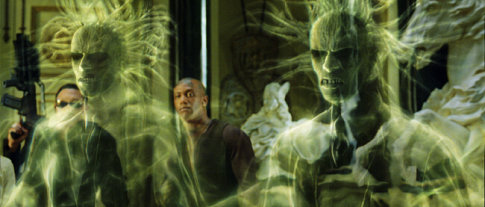
Seeing Beyond the Sign
The "Signs" section of Chapter 3 of How to Read a Film outlines the Icon-Index-Symbol "trichotomy" that Peter Wollen borrowed from philosopher C. S. Peirce. Because it is central to understanding the semiology of film, it is worth revisiting.
These are the three basic ways in which signifier and signified relate to each other in the sign. When a sign is iconic, signifier equals signified. What you see is what you get. No need to talk about that. When a sign is symbolic, the relationship between signifier and signified is arbitrary―that is, we have to learn it. This is sort of like looking up words in a dictionary. You don't know why they mean what they mean, but they do. The problem in film is that often you don't know that you don't know what that "word" means! The only way around this is to get familiar with the history of film (and other cultures) and ask questions.
The really interesting area is in the middle. If a sign is indexical, the relationship between the signifier and the signified is neither obvious nor arbitrary. Without going to the "dictionary," you can figure it out. This is the area of metaphor. How to Read a Film extends the metaphorical logic of the index by borrowing three terms from classical rhetoric: metonymy, synecdoche, and trope.
As you'll recall from the book, a metonymy is a figure of speech in which an associated detail invokes or represents the whole. A synecdoche is a figure of speech in which a part stands for the whole, or the whole for a part. And a trope is a "turn of phrase," a logical twist that gives the elements of a sign new meaning.
Christian Metz noted that movies are rich with what he called "short-circuit signs." This is why you can watch a film without having gone to school. A picture of Robert DeNiro is a picture of Robert DeNiro; a punch in the mouth is a punch in the mouth. But there is more to those "signs" than you might think. DeNiro and the punch are very different in Goodfellas from what they are in Raging Bull. Just because these signs are short-circuits doesn't mean they aren't rich with connotations. Goodfellas is a gangster movie; punches in Goodfellas are antisocial acts. Raging Bull is about boxing; punches in Raging Bull are professional actions.
 |
||||
| The films of Ingmar Bergman, such as The Seventh Seal, are rich studies in symbolism and metaphor for cinema academics to dissect. | ||||
Think back to the films we've seen. Remember that train entering the tunnel in North by Northwest (juxtaposed with Cary Grant pulling Eva Marie Saint into the upper berth)? What about being attacked by an airplane in a midwestern cornfield? How about all those doors in the farce A Funny Thing Happened on the Way to the Forum? Or the breakfast scene montage in Citizen Kane? How does a gag work in silent comedy? How is it set up to be funny? What does it mean when Dave drops the fork in the last sequence of 2001: A Space Odyssey?
By now, you should have a finer appreciation of how these cinematic signs accomplish their aims.
If you find semiological terms useful, great. If it sounds like putting too fine a point on it, forget them. The bottom line is that what you see (or hear) on film often carries with it a meaning that is not obvious on the face of it. In mysteries, of course, this connotation is part of the plot. In other films, it's not significant to the story, but it does add greatly to the experience.
Many of the illustrations of these phenomena in How to Read a Film are taken from the films of Ingmar Bergman. In the 1950s and 1960s, when Bergman did his most influential work, film study was coming of age academically. Bergman's work was quite useful to the academics because it employed so many of these rhetorical devices. English majors could really sink their teeth into The Seventh Seal or Wild Strawberries! Bergman's films were understandable to people who had studied rhetoric and knew about symbolism and metaphor.
If you want an antidote to this English-major syndrome, search out the 15-minute parody of Bergman made by George Coe and others in the mid-1960s called "De Düva." (It's available on the How to Read a Film DVD-ROM.) But don't watch this parody until you've seen all of Bergman's best films - they are powerful emotional statements and among the great works of cinema. "De Düva" is such a cutting parody it may very well destroy them for you. (George Coe was later one of the original cast members of Saturday Night Live. That shows you where he was coming from.)
Syntax: Can You Speak "Movie"?
The "Syntax" section of Chapter 3 of How to Read a Film is the heart of the book. Here is where we discuss many of the basics of film esthetics: mise-en-scène and montage; the framed image versus the diachronic shot (the shot over time); open versus closed forms; deep focus versus shallow focus; the planes of composition; angles and color; multiple images and focus; tracks versus zooms versus stationary cameras; narrative and camera points of view; actual versus commentative sound; invisible cutting versus postmodern editing; autonomous shots versus related shots; and punctuation!
In other introductory film texts, this material might take up most of the book. Why is it condensed here into half a chapter?
Well, it's presented in this way for two main reasons:
That doesn't mean you shouldn't spend a good amount of time studying these concepts. You should. It's a good idea to make a crib sheet of these basic rules of film syntax and watch a few films while comparing them to your checklist. Or better yet, take a few individual shots or scenes (this is relatively easy with DVD or TiVo) and run through them against the crib sheet.
If you do this with the most popular films of the last 10 or 15 years - the ones that win the weekend box-office contest - you are likely to find a fairly simple set of characteristics (by matthew abernathy). It's not that these esthetic rules don't apply to such films; they do. But such esthetics often get in the way of action, adventure, and excitement. What wins box-office contests these days is more a matter of content than of style.
 |
||
| Digital morphs are an important part of the syntax of The Matrix Reloaded. In the film, the morph technique helps the audience identify what is real and what is not. The twins shown here have the power to morph in and out of tangibility. | ||
For example, the Andy and Larry Wachowski's Matrix series (The Matrix, 1999; The Matrix Reloaded, 2003; The Matrix Revolutions, 2003) depends entirely on two elements: special effects morphs and the intriguing concept (always important in science-fiction films). Because morphing is infinitely variable, it is hard to develop an esthetic of morphs. How is one morph different from another? How is a morph different from a cut? (Rhetorically, the morph may be a new category to add alongside the index, the symbol, and the icon. Morphs connect two separate images in a way that forces a different comparison.) As for the concept, the matrix is an important idea. The only problem is that the film was made by people stuck inside the matrix who can only imagine what it is like outside!
Christopher Nolan's remarkable Memento (2000), on the other hand, is a symphony of signs! The main character, played by Guy Pearce, has to write down or photograph everything that happens or he won't remember. Indeed, you could say that Memento is a movie about a private semiology and how it solves a crime and rights a wrong.
Films don't have to have a complex semiology to succeed. But when they do, they stand up to repeated viewings a lot better.
Armed with this set of syntactical rules, you are ready to conquer film esthetics. Compare what the filmmaker did with what he or she didn't do (the paradigmatic axis). Compare what the filmmaker is doing now with what he or she did before (the syntagmatic axis). But always remember that understanding esthetics is just the beginning of understanding how a film works.
As Christian Metz so eloquently put it: "A film is difficult to explain because it is so easy to understand."